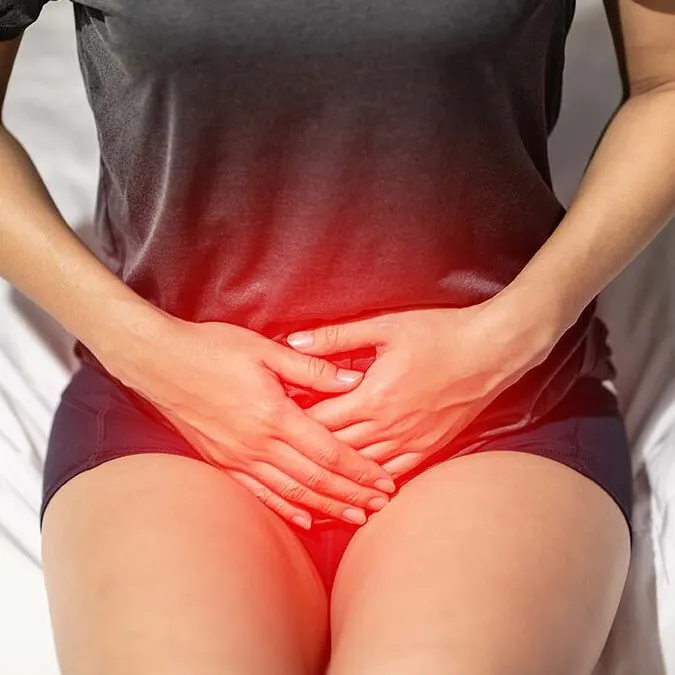
Published on: 23 March, 2021
Read Time: 7 min
Abnormal vaginal bleeding refers to any vaginal bleeding that differs from your normal menstrual cycle. This can include:
- Bleeding Between Periods: Unexpected bleeding or spotting that occurs between your regular menstrual cycles, which might be just a few drops of blood or a heavier flow
- Excessively Heavy Periods (Menorrhagia): Where the bleeding is so heavy that you need to change your pad or tampon more often than every 1-2 hours, or you experience bleeding that includes large blood clots.
- Prolonged Bleeding: Menstrual bleeding that lasts longer than 7 days, extending beyond the length of a typical menstrual cycle, which can lead to additional health concerns such as anemia.
- Unpredictable Menstrual Cycle: Experiencing significant irregularities in the timing of your periods, such as having cycles that are much shorter or longer than the typical 21-35 days.
- Postmenopausal Bleeding: Any bleeding that occurs after menopause, when menstrual periods have ceased for 12 consecutive months, which always warrants a prompt medical evaluation.
Variations from what a woman considers her “normal” can be a significant source of worry or distress. In this discussion, we’ll delve into the most common causes of abnormal vaginal bleeding and highlight when it’s necessary to consult your doctor.
Causes of abnormal vaginal bleeding
- Endometriosis: A condition where tissue similar to the lining inside the uterus grows outside it, causing painful periods, heavy periods, and possible fertility issues.
- Fibroids: Non-cancerous growths in the uterus that can lead to heavy or prolonged periods and other symptoms, varying greatly in size and impact.
- Polycystic Ovarian Syndrome (PCOS): A hormonal disorder causing enlarged ovaries with small cysts on the outer edges, associated with irregular menstrual cycles, and potentially leading to abnormal bleeding patterns
- Menopause-Related Bleeding: Bleeding that occurs after a woman has reached menopause, which can be a sign of hormonal changes or other health concerns needing medical evaluation.
- Medications: Certain medications, like birth control pills or intrauterine devices (IUDs), can cause or alter vaginal bleeding patterns, ranging from spotting to heavy bleeding.
When vaginal bleeding is abnormal
Most women have a general idea of what their period is like -how long their period lasts, how heavy the bleeding is, when their period is scheduled to arrive and how much pain it causes. If your period deviates significantly from what is ‘normal’ for you, this may be abnormal bleeding and should be addressed by your doctor. Vaginal bleeding may be considered abnormal in the following cases:
- Menstrual periods that last longer than seven days (menorrhagia)
- Menstrual periods that are particularly heavy (ie. needing to change a pad or tampon every hour or two)
- Menstrual periods that are light or irregular
- Menstrual periods that are absent
- Bleeding in between periods (ie. small spotting of small amounts of blood between periods)
- Bleeding after menopause -either light or heavy
Diagnosing abnormal bleeding
Diagnosis of abnormal bleeding will depend on the underlying cause of the bleeding. Your doctor will take a full medical history, carry out an examination and refer you for further diagnostic testing if needed.
Treating abnormal bleeding
Treatment options will always depend on the original cause of the bleeding. Depending on the cause this may include prescription medications, recommendations to focus on lifestyle changes (ie. diet, smoking, alcohol) or in rare cases surgical options. All options are always discussed in full with our patients. This way, patients can make an informed decision about treatment options that are best for them and their future health.
The following section goes into more detail about the causes of abnormal bleeding.
Endometriosis
Endometriosis is a medical condition in which cells that normally line the inside of the uterus (the endometrium) begin to grow on the outside of the uterus instead. Endometriosis commonly involves the ovaries, fallopian tubes and tissue lining the inside of the pelvis. Endometriosis can lead to symptoms of:
- Pelvic pain (often associated with periods)
- Heavy bleeding
- Cramping
- Painful intercourse
- Pain during bowel movements or urination
Women who experience these symptoms should speak to their doctor as soon as possible. Endometriosis can be mistaken for other medical conditions. Therefore, formal diagnosis must always be sought. Additionally, left untreated, endometriosis can cause problems with future fertility or lead to pregnancy complications. An early diagnosis can provide appropriate treatment and help stop complications from occurring.
Diagnosis
Endometriosis can be diagnosed by your doctor after a full examination. Ultrasound testing or blood tests may also be required.
Treatment
The treatment of endometriosis will be based on the severity of your symptoms, severity of the disease and your wish to have children in the future. Treatment options range from medications to surgery. All options, their risks and benefits will always be discussed in full with patients.
Fibroids
Uterine fibroids are non-cancerous growths of the uterus that often appear in women during their reproductive years. Although 70-80% of women will develop a fibroid by the age of 50, the vast majority of fibroids cause no symptoms and go completely undetected.
Fibroids are sometimes called uterine myomas, fibromyomas or leiomyomas. They vary in size and shape and can be as small as a pea or as big as a melon. In the cases where fibroids become large they can develop into a bulky mass that can distort the entire shape of the uterus and start to affect its function.
Fibroids don’t always cause symptoms but when they do, the following may be experienced
- Pelvic pain or severe menstrual cramps
- Unusually heavy menstrual bleeding that may include clots
- Bleeding between periods
- Increased urination frequency
Treatment
The treatment of fibroids will depend on the size and location of the fibroid. It will also depend on your personal medical history and plans to have children in the future. Treatment options range from medications and contraceptive pills to surgery.
Polycystic Ovarian Syndrome (PCOS)
Polycystic ovarian syndrome (PCOS) is a medical condition caused by an imbalance of the reproductive hormones. Both estrogen and progesterone help to control things like our menstrual cycle, ovulation, fertility and pregnancy. Because these hormones are so important, the body tightly controls the amounts produced by the body. But in PCOS, the normal regulation of these hormones becomes disrupted. The resulting hormonal imbalance is what leads to symptoms such as:
- Irregular periods (ie. an infrequent, heavy or prolonged menstrual cycle)
- Acne
- Excess facial and body hair
- Weight gain and infertility
Polycystic ovarian syndrome is a very common medical condition. Most often, women find out they have PCOS in their twenties and thirties when they have problems getting pregnant and first see their doctor.
Diagnosis
Your doctor will take a full medical history and carry out a physical exam. In some cases they may also order a blood test or scan to confirm the diagnosis or rule out other possibilities.
Treatment
There is no definitive cure for PCOS but there are many ways to help manage its symptoms. Treatments options will take into account the severity of your symptoms, plans to have children in the future and your own personal choice about what treatments you think are best for your lifestyle. These options may include birth control pills, changes to diet and lifestyle or other medications.
References
- https://www.nichd.nih.gov/health/topics/uterine
- https://www.uptodate.com/contents/epidemiology-clinical-manifestations-diagnosis-and-natural-history-of-uterine-leiomyomas-fibroids?source=search_result&search=fibroid&selectedTitle=2~150#H5291363
- https://www.ncbi.nlm.nih.gov/pmc/articles/PMC2766886/
- https://www.womenshealth.gov/a-z-topics/polycystic-ovary-syndrome





